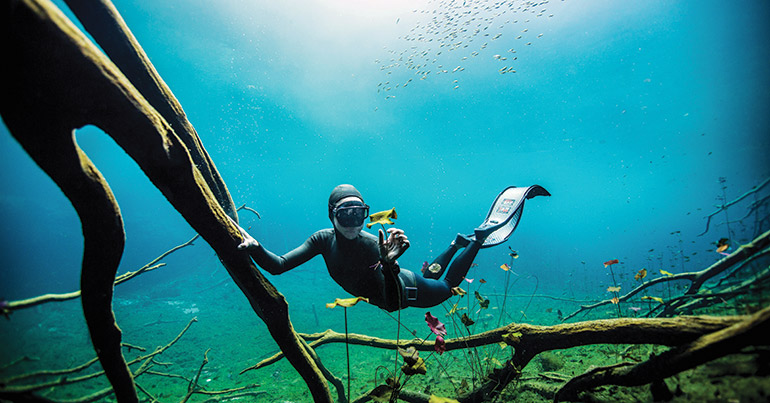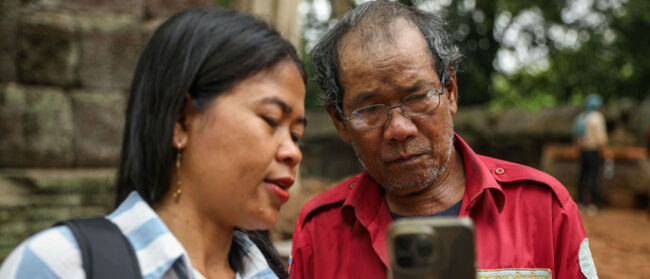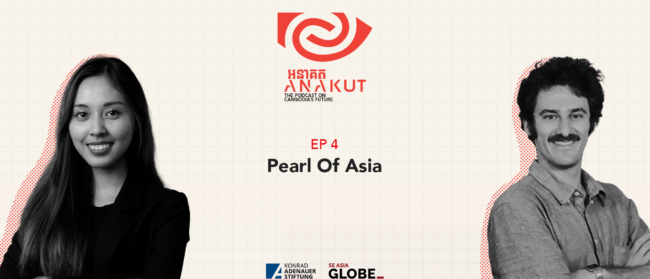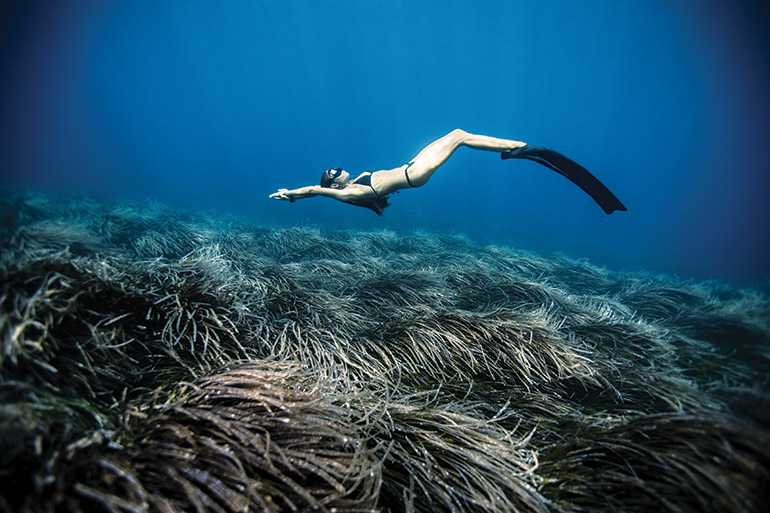
Scuba diving in the sapphire blue depths of the Gulf of Siam, 30m beneath the waves, you may encounter a couple of mermaids, twisting and twirling between parrotfish and rich coral reefs. But on closer inspection, you will soon find that these mythical marine creatures are actually two monofin-wearing, athletic and savvy business owners, Monica Ganame and her business partner, Eusebio Saenz de Santamaria. The pair are freedivers, practitioners of an extreme yet ethereal sport that in principle is simple: divers take in a large gulp of air and plunge down as far as they can – minus oxygen tanks – before rising again to the surface.
Freediving was formalised as a competitive sport in the 1960s, but has been practiced for thousands of years. Ancient Greeks would dive for clams and sponges, while 2,000 years ago the famous Ama women of Japan would descend into the deep blue abyss, returning with clutches of oysters and pearls. These days, competitive freediving features a plethora of rules and categories – such as ‘free immersion’, ‘constant weight’ and ‘constant no fins’ – overseen by its peak body, AIDA (the International Association for the Development of Apnea).
The last decade has seen a surge of interest in the sport, according to AIDA, as more and more adventurous travellers seek out the world’s depth-defying thrills. In 2011, AIDA had recorded just 2,382 enrolments in its educational courses; by 2015 that figure had increased to 6,883. But as Ganame and Saenz de Santamaria are proving through their hugely successful freediving company, Apnea Total, which has its head office on the paradisiacal Thai backpacker island of Koh Tao, the sport is not just for thrill seekers – it is as much about mediation and philosophy as it is about adrenaline-fuelled adventure, and is thus attracting a diverse mix of customers.
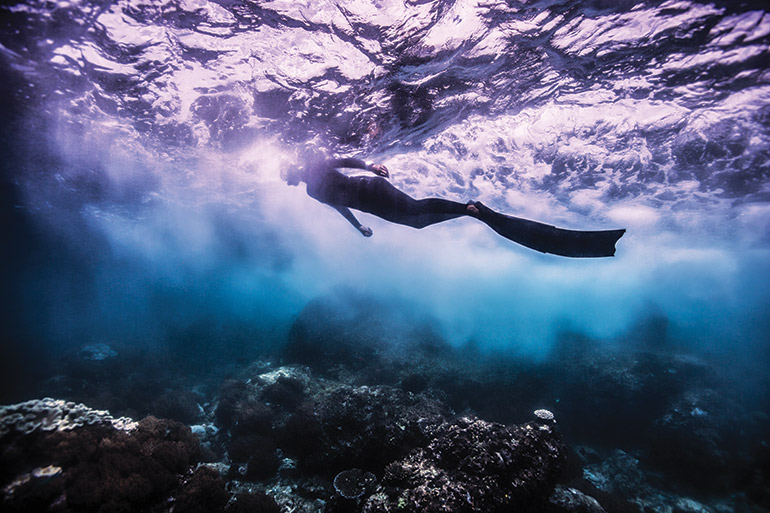
The pair co-founded Apnea Total in 2004 as a small, laidback operation run out of a scuba diving company’s boat on Koh Tao. Both Ganame, from Argentina, and Saenz de Santamaria, from Spain’s sun-kissed Bilbao region, had been competitive freedivers in Europe and northern Africa, breaking records in Egypt’s Red Sea and the Caribbean (Saenz de Santamaria can dive to 105m), but both had grown weary of competitions. When they arrived in Thailand, the duo set up Apnea Total, mainly so that they could take their backpacking friends out into the ocean and let them in on their “secret world”.
“We wanted to share with people the beauty of the ocean we discovered,” said Saenz de Santamaria, who confessed that in the early days, the only form of marketing they relied on was word of mouth. “We didn’t have any money for an office or boat, so [the partnership] really helped us. Soon, there were more freedivers coming out with us than scuba divers with the other company, so we knew we were on to something,” he said.
Today, Apnea Total is a recognised international freediving organisation offering its own certification, the Apnea Total Freediving Education System. It is now one of the three biggest and most recognised certifying freediving outfits in the world – the other two are AIDA and scuba diving giant PADI – with courses running the gamut from basic freediving to teacher-trainer certification. Apnea Total has also expanded globally, with 12 schools in diving hotspots such as Indonesia, the Philippines, the Maldives and Honduras.
The company’s records show that they have now taught more than 12,000 freedivers at their centres – an impressive figure considering that AIDA, which runs the most freediving educational courses around the globe, has recorded 21,099 over the last five years. AIDA’s media officer Alexandru Russu said the freediving community is probably triple that figure – predicting there would have been about 65,000 enrolments in AIDA and other courses such as PADI and Apnea Total to date.
“The community is constantly increasing year-on-year, and the numbers we have until now for 2016 confirm the continuation of this strong dynamic in our sport,” Russu said in an email.
While a humble Saenz de Santamaria puts much of Apnea Total’s success down to luck and “the right place and right time”, it is evident that foresight and strategy have played major roles in the school’s achievements.
While Saenz de Santamaria and Ganame had, as divers, been naturally drawn to the Gulf of Siam’s idyllic, warm islands, the location of their startup had been subconsciously strategic: thousands of water-loving backpackers flock to Koh Tao each year to take PADI scuba diving courses, so it was the obvious place to set up a freediving school.
“We soon learned there was already a lot of interest in freediving by locals and travellers and what was needed was a freediving school with a structured and, most of all, safe method of education,” said Saenz de Santamaria.
“Backpackers are more open during their travels and looking for new adventures. I believe it worked well because our philosophy was never to set up a huge business, but more to show the others that they could do the same as us under the water,” he said.
It was a passion project, Ganabe added, and they had gone into it with the knowledge that they might fail. A number of her friends back in Egypt had tried to set up their own freediving schools just a few years earlier and had not been able to sustain interest in their courses. She and Saenz de Santamaria were astonished that while they were enrolling 20-25 students a month in their first year, their freediving peers back in the Red Sea were only enrolling about five a month. “When we started to grow early on, and the cash came in, we went ‘wow, this is something organic’. I think it was a combination of the right moment, the right place and the fact we had a passion and did not have a business mindset,” she said.
The quick success of the Apnea Total model could also have been the inclusive approach they fostered from the beginning. “We wanted it to be for everyone and anyone, not just for a small, elite group of athletes, which many of the other schools were shaped towards,” Ganame said.
Another appeal of the earlier Apnea Total courses, Saenz de Santamaria added, was the flexibilty in their teaching methods. “We have learned that everyone who comes to freedive with us is a completely different individual with their own fears, virtues and goals, and therefore we adapt to their needs to offer an individual experience.”
Apnea Total’s main point of difference, though, is its unconventional and intensive, yet nurturing certification courses, according to students such as Charlotte Pert, who is currently training with Apnea Total as an instructor in Coron, the Philippines. “They have higher standards, in my opinion, despite [the fact that] they are perhaps not as well-known as [AIDA and PADI],” she said. Apnea Total’s beginner courses dedicate 60% of time to practical exercises like breathing and spending time in the water rather than theory. Another difference is that, like the AIDA system, they are completely dedicated to freediving rather than also teaching scuba courses.
“Many other courses target competitive divers but for us it’s about fun. [Competitive freedivers] can get caught up with depth, numbers and time; for us more than anything else it is about relaxation and safety, and I think that’s part of our appeal. We don’t push students – depth will come with time and practice,” said Ganame.
That said, the maximum depth (on an open water ‘dive line’, which is a rope the diver uses to pull themselves down and up with when participating in ‘free immersion’ freediving) of Apnea Total’s ‘Freediver Course’ was 20m, while PADI’s was 10m. Apnea Total’s ‘Instructor Course’, meanwhile, takes students two weeks to complete whereas the PADI equivalent takes a minimum of four days.
“Becoming an instructor is a constant learning process,” said Saenz de Santamaria. “Our course takes two weeks, plus another two weeks of full-time practice, but if people need more time it’s OK, everybody is different. Instructor training is never complete anyway; there is a lot of psychology involved. We also don’t have exams for instructor courses – we decide when they are ready, and they know when they are ready.”
While Apnea Total now partners with big brands such as the luxury hotel chain Dusit, the founders said their biggest success had been their model of training up freediving teachers who then set up their own Apnea Total schools around the world. The bonds that the duo formed with their newly certified instructors have built the strong foundations of these new schools, of which there are now 12. The founders charge each new school about $500 a year to cover website costs, certification costs and an online communication system, but receive no other royalty fees. “I feel like it would be a bit greedy to charge for our name, and it’s more about strengthening our brand,” said Saenz de Santamaria. “Students may dive in Gili Air, and then go ‘which corals can I see next?’ and we can recommend them to any of our schools. We have 100% trust in the schools – we only let our most skilled instructors start them up.”
Watching the Apnea Total founders, or any of their undulating, graceful team, in the water is a breathtaking experience. Their streamlined forms and sublime movements imbue the sport with a seemingly pure and organic nature, despite the fact that these are humans in their most unnatural element. This could be why, more recently, the mainstream media has picked up on freediving, publishing exquisite, dreamlike photo essays and videos in popular magazines and websites.
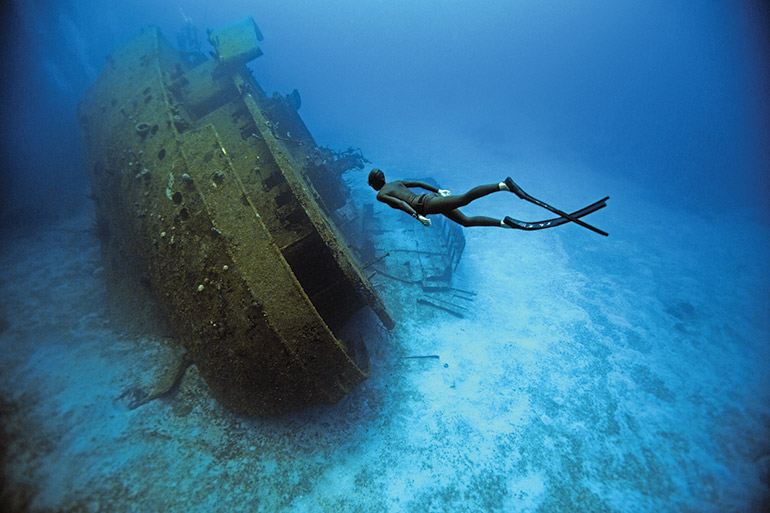
In 2005, Saenz de Santamaria met his now-wife, Christina, who was a student at Apnea Total. The couple, both self-taught photographers, soon formed One Ocean, One Breath, a photography and videography service whose underwater images appear across these pages. They now collaborate with the Discovery Channel, The Guardian, National Geographic and more. This side project has had profound marketing impacts for the Apnea Total brand, Saenz de Santamaria said. “It just started as a hobby, but the exposure it has brought our business has been huge, particularly in this age of digital media, as well as traditional print. We’re now commissioned to photograph extraordinary, far-flung places, which is a dream – we live to travel.”
Indeed, the ‘digital age’ has helped the business too, particularly when it comes to social media, said Saenz de Santamaria – One Ocean, One Breath now has 25,000 followers on Facebook. “We have many freedivers hunting us down online now. When we started our little business, our clients were made up of 80% walk-ins. Now we have 40-50% booking online.”
Originally, Apnea Total’s target market had been backpackers, but that is changing, too. They now receiv a diverse mix of “budget travellers, affluent tourists, families with children and 60-year-old adventure-seekers; Europeans, Aussies, Singaporeans, Thais,” said Ganame. The Chinese market has become a huge source of revenue, which initially took the Apnea Total founders by surprise. “My advice to anyone with a tourism business – whatever its shape or form, wherever you are – would be to tap into this market right now,” said Ganame. “There is a big invasion of them, which is great for us,” she added with a laugh.
Despite the fact they preferred to keep tight control and leadership of their freediving school, Ganame and Saenz de Santamaria decided early on that they would fare better to form a partnership with a tourism operator to work with the Chinese market. “We took time to choose the right people – they were business people and divers who had taken our courses before. We also certified Chinese instructors free of charge. We go halves with them – they receive 50% of the profit, and it works. They understand their market better, the body language and culture,” Ganame said.
Saenz de Santamaria said the most important piece of advice he had for small tourism-geared startups would be to sniff around for what services are lacking in an area, and dive in. “Check if there is a real need for what you offer in a particular place and, if there is not one, create it. If it is already offered by other companies, then improve it with what elements the others are lacking.”
He said that forming friendships with similar companies, such as the scuba diving school they originally partnered with, had helped them to keep startup costs down and could prove a good model for others to emulate. “We only invested $2,000 for some equipment to begin with. You need to make [the partner] see the benefit they’ll get, though. The scuba dive school got 20% of our customers directed to them, and all we did was take up space on their boat, which they were happy with,” he said.
With their profits, Apnea Total has now branched out into providing accommodation on Koh Tao. They have invested in luxury villas and are in the construction phase of a “huge 150-bed hostel to service our divers,” said Saenz de Santamaria. The biggest profit for him, though, was the lifestyle his business had provided him. “I work here on Koh Tao for six months, and spend the other six months travelling. You can take a hard business approach and try to be on top of everything, but it burns you out. To find the right staff, to delegate and find time to be happy makes a huge difference when it comes to success,” he said.
“How big we are planning to be, I don’t think about that too much. We just go day by day… but I guess the sky is the limit.”
